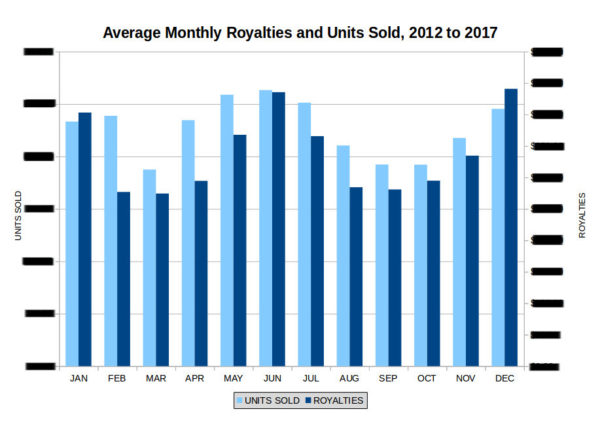As I mentioned in a previous post, I’ve been crunching the data from my last seven years of indie publishing, and it’s yielded some very interesting information. Here’s another graph that I managed to pull out:
 This graph shows all of the monthly averages for royalties earned and units sold, across all my books, from 2012 to 2017 (excluding February 2017, which was an outlier due to having a book in a story bundle). I haven’t adjusted for anything else, such as new releases or total books out, so take it with a grain of salt.
This graph shows all of the monthly averages for royalties earned and units sold, across all my books, from 2012 to 2017 (excluding February 2017, which was an outlier due to having a book in a story bundle). I haven’t adjusted for anything else, such as new releases or total books out, so take it with a grain of salt.
One of the big assumptions and/or questions in the book world regards the existence of a “summer slump,” where books (depending on genre) don’t generally sell as well and people generally aren’t reading. Judging from the data and my own experience, there does appear to be a slump from August to October. However, there also appears to be a “midwinter slump” from February to April.
The interesting thing is that units sold don’t appear to dip all that much, for whatever reason. It’s just the royalties that are affected. And in December and January, readers appear to be willing to buy more expensive books, as the royalties go up by more than units sold.
From this, it appears that the prime time of the year for bookselling are November to January and May to July. Of course, bear in mind that this is only my anecdotal experience, and the plural of anecdote is not data.
If I had to hazard a guess as to what is going on, it would be that readers are tighter with their money in the months following the holidays, and that the summer doldrums do indeed tend to stifle their enthusiasm for books. Interestingly, though, there seems to be a spike in reading with the spring, perhaps as they come out of hibernation.
Of course, it’s also possible that my own enthusiasm for marketing and publishing is greatest in the spring and early summer, and tends to fall off with the winter cold and the summer heat.
Either way, my own data tend to suggest that yes, there is a summer slump.